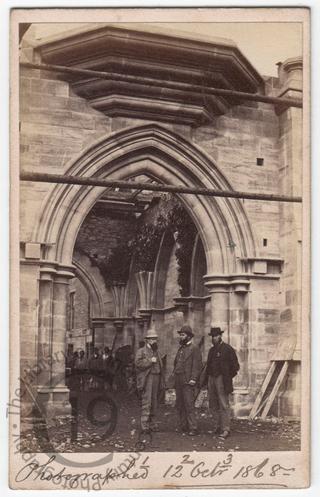
Construction at the University of Glasgow
A carte-de-visite taken during the construction of the of the ‘New University Buildings’ at Gilmorehill in Glasgow, showing three standing at one of the entrances to the cloisters.
An inked inscription in the lower margin reads ‘Photographed 12 Octr. 1868’ and numbers each of the three men. A key verso in the same handwriting identifies them as ‘2 - Mr Bradford / Manager / 1 - G. Henson F’man Masons’ and ‘3 - E. Frisby do. Joiners.’
‘ NEW UNIVERSITY BUILDINGS / SOIREE TO THE WORKMEN — Mr Gilbert Thompson, of Peterboro’, the enterprising contractor for the mason and wright work of the New University Buildings, gave a grand entertainment, yesterday evening, to the workmen of his employment, together with their wives and daughters, in honour of the royal ceremonial on Thursday. The building intended for the Library of the University, 169 feet long and by 60 feet wide, although far from finished, was cleverly and comfortably adapted for the occasion, by being temporarily floored and roofed in. A platform was erected at the west end from which ran nine tables the whole length of the building. […] Mr Thompson then addressed his people at considerable length, in a clear, ringing voice, which was distinctly heard in the remotest corners of the immense hall. He congratulated the workmen — as well as foremen Messrs. Bradford, Frisby, and Henson — on the good feeling, which prevailed between the employer and the employed’ (Glasgow Evening Citizen, 10 October 1868).
This hadn’t always been the case. Work on the project had been held up by a masons’ strike in June 1867 (Glasgow Herald, 7 June 1867).
‘THE UNIVERSITY BUILDINGS AT GILMOREHILL — The great building is now so far advanced that spectators, even at a distance of several miles, are able to forma a fair conception of its character, proportions, beauty, and grandeur. All our readers know that the site is unrivalled, and the building itself promises to be an honour to the city, and a credit to Mr [George Gilbert] Scott, the architect, Mr Thompson, the contractor, and to Mr Bradford, the energetic and obliging superintendent of work’ (Glasgow Herald, 19 April 1869).
‘PRESENTATION TO MR BRADFORD — At the close of work yesterday, the various classes of operatives assembled in front of the offices, when Mr Bradford was presented with a substantial mark of the esteem and respect entertained towards him. The testimonial took the form of an elegant gold watch and Albert chain […] the watch bearing the inscription “Presented to William Bradford, as a token of respect and esteem, by his fellow-workmen at the New University Buildings, Gilmorehill, Glasgow, 5th July, 1869.” Accompanying this was an elegant present for Mrs Bradford, in the shape of a silver teapot, cream jug, and sugar basin. Mr GEORGE HENSON made the presentation on behalf of his fellow-workmen. He spoke of the uniform kindness shown to all classes by Mr Bradford during the progress of the works, and expressed a home that their acting manager might long be spared to wear the token of their esteem with which they presented him’ (Glasgow Herald, 6 July 1869).
‘NEW UNIVERSITY BUILDINGS — Presentation — On Saturday evening the joiners in the employment of Mr John Thomson, contractor for the joiner work of the New University Buildings, Gilmorehill, met in the dining room of the Tontine Hotel for the purpose of presenting Mr Edward Frisby, their foreman, with a testimonial.’ During the evening ‘the Chairman called for a bumper to the health of Mr Edward Fristy, a straightforward gentleman, whose every action was becoming an Englishman.’ The joiners ‘presented Mr Frisby with a valuable gold watch and appendages, and a beautiful gold brooch for Mrs Frisby’ (Glasgow Herald, 29 August 1870).
According to the website the University of Glasgow: ’The new University buildings were inaugurated on 7 November 1870 [although] The tower, cloisters, great hall and west quadrangle remained unfinished. New funds became available in 1877 but the architect George Gilbert Scott died a year later, in 1878. It was left to his son, John Oldrid Scott, to finish the work.’ The building’s distinctive tower and spire were designed by the son rather than the father, the latter having originally intended a heavier-looking clock tower..
Photographer unidentified.
Code: 127843




